More KNN & Trees
As we gather
- Sit with your assigned group.
- Introduce yourself!
- Ask about Spring Break
- Open today’s Rmd
Announcements
MSCS Events
Thursday at 11:15am - MSCS Coffee Break
- Smail Gallery
This weekend, Data Fest (register at https://www.macalester.edu/datafest/registration/ by tomorrow!)
Monday, March 25, 4:45pm, JBD: MSCS & Society Lecture
- “Designing Mixed-Reality and Tangible Data Experiences with Artists and Indigenous Communities” by Dr. Daniel Keefe, U of M
Where are we?

CONTEXT
world = supervised learning
We want to model some output variable \(y\) using a set of potential predictors (\(x_1, x_2, ..., x_p\)).task = CLASSIFICATION
\(y\) is categoricalalgorithm = NONparametric
GOAL
Build and evaluate nonparametric classification models of some categorical outcome y.
Quick Recap
How do we evaluate classification models?
- In sample v. Cross-Validated
- What is the difference conceptually?
- What if the values are different? What if the values are similar?
Binary Metrics
- Accuracy (overall; compare to no information rate = frequency of largest class)
- Sensitivity (accuracy among Y = 1, true positive rate, recall)
- Specificity (accuracy among Y = 0, true negative rate)
- False Positive Rate = 1 - Specificity
- ROC AUC (accounts for many thresholds)
- the probability that a randomly chosen case from the Y=1 class will receive, from the classifier, a higher predicted probability than a randomly chosen case from the Y = 0 class
More Binary Metrics [optional]
- False Negative Rate = 1 - Sensitivity
- J Index = Sensitivity + Specificity - 1
- Balanced Accuracy = (Sens + Spec)/2
- Kappa (how much better your model is over using class frequencies)
- MCC (correlation between truth and prediction)
- Positive Predictive Value (accuracy among those we predicted Y = 1, precision)
- Precision-Recall AUC (accounts for many thresholds)
- F measure = \((1 + \beta^2) * precision*recall/((\beta^2*precision) +recall)\) (chosen beta gives one or the other more weight)
Multiclass Metrics
- Accuracy
- Many binary metrics can be generalized to multiclass situations (optionally see https://yardstick.tidymodels.org/articles/multiclass.html, https://www.evidentlyai.com/classification-metrics/multi-class-metrics)
Data Motivation
Aerial photography studies of land cover is important to land conservation, land management, and understanding environmental impact of land use.
IMPORTANT: Other aerial photography studies focused on people and movement can be used for surveillance, raising major ethical questions.
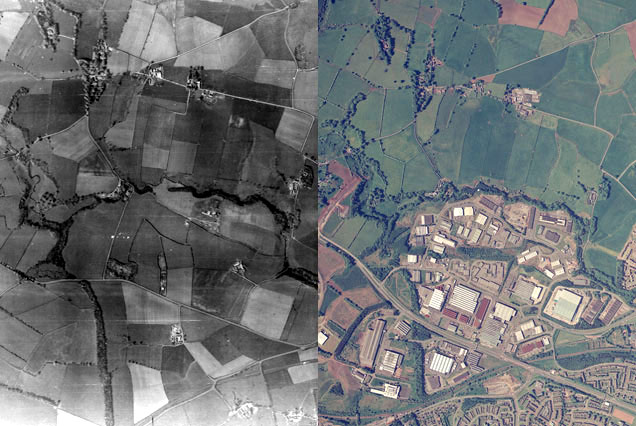
# There are 9 land types!
# Let's consider all of them (not just asphalt, grass, trees)
land %>%
count(type) type n
1 asphalt 59
2 building 122
3 car 36
4 concrete 116
5 grass 112
6 pool 29
7 shadow 61
8 soil 34
9 tree 106


EXAMPLE 1: KNN
Check out the classification regions for two KNN models of land type by Mean_G and NDVI: using K = 1 neighbor and using K = 16 neighbors.
Though the KNN models were built using standardized predictors, the predictors are plotted on their original scales here.
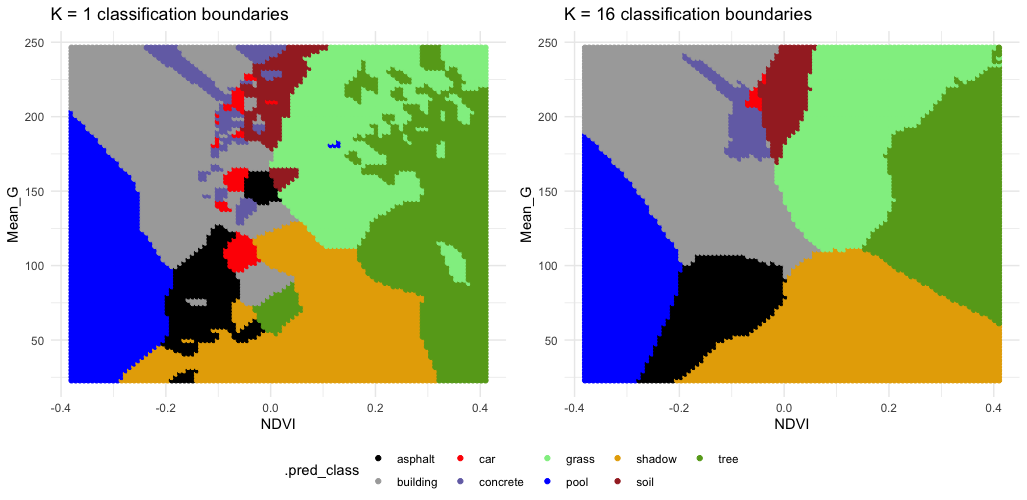
Follow-up:
- What do KNN regression and classification have in common?
- How are they different?
- What questions do you have about…the impact of K, the algorithm, or anything else KNN related?
EXAMPLE 2: Pruned tree
Next, consider a PRUNED classification tree of land type by Mean_G and NDVI that was pruned as follows:
- set maximum depth to 30
- set minimum number of data points per node to 2
- tune the cost complexity parameter.
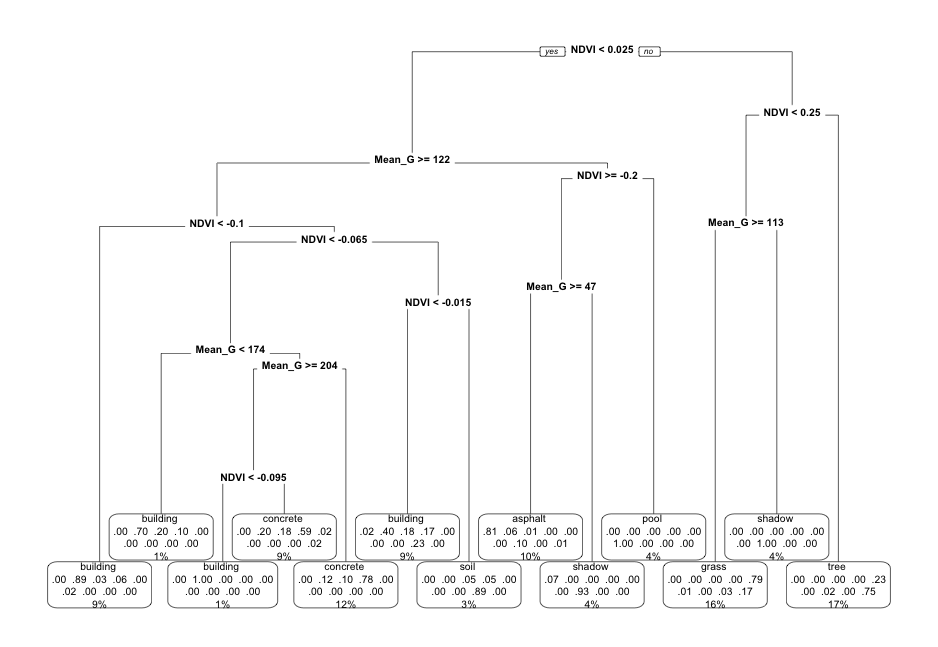
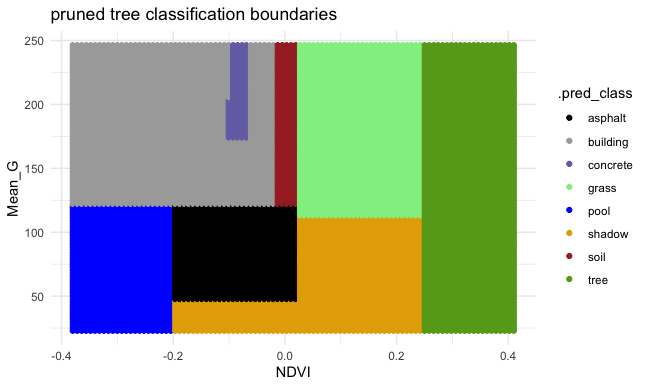
Follow-up:
- What category is missing from the leaf nodes?
- Why did this happen?
- What questions do you have about…the algorithm, pruning, or anything else tree related?
EXAMPLE 3: Unpruned tree
Finally, consider a (mostly) UNPRUNED classification tree of land type by Mean_G and NDVI that was built using the following tuning parameters:
- set maximum depth to 30
- set minimum number of data points per node to 2
- set cost complexity parameter to 0.
Check out the classification regions defined by this tree:

And the tree itself.
This tree was plotted using a function that draws the length of each branch split to be proportional to its improvement to the classification accuracy. The labels are left off to just focus on structure:
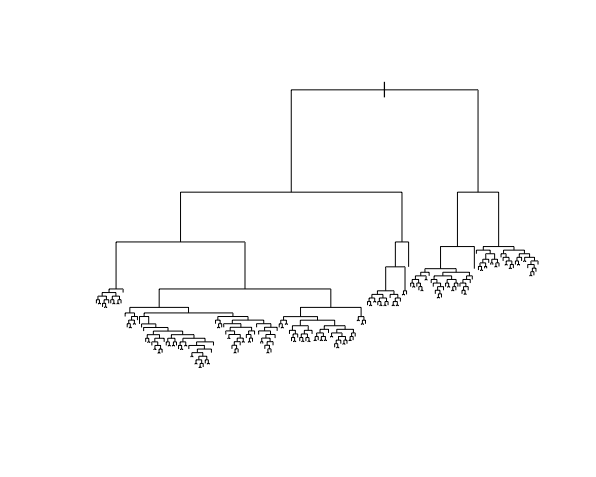
- What happens to the length of the split branches the further down the tree we get? What does this mean?
- What are your thoughts about this tree?
- What questions do you have about the impact of the tuning parameters, or anything else tree related?
New Concepts
Gini Index: Node Purity Measure
\[G = p_1(1-p_1) + p_2(1-p_2) + \cdots + p_k(1-p_k)\]
- “probability of misclassifying a randomly selected case”
- Smaller signals “better” classifier
- Used to decide whether or to split based on the cost-complexity parameter (default in rpart)
[Optional] Information/Entropy Index: Alternative to Gini
\[I = -(p_1\log(p_1) + p_2\log(p_2) + \cdots + p_k\log(p_k))\]
- “measure of amount of uncertainty in the data”
- Smaller signals “better” classifier
- Used to decide whether or to split based on the cost-complexity parameter (option in rpart)
Small Group Activity
For the rest of the class, work together on Exercises 1-10.
After Class
Upcoming due dates
- Tonight: HW 5 (Grace Period ends)
- 3/28: HW 6
